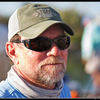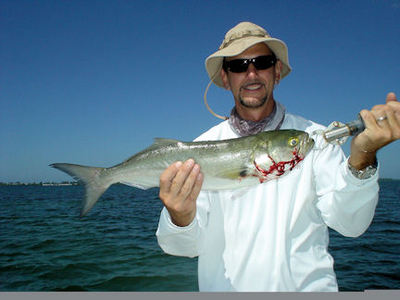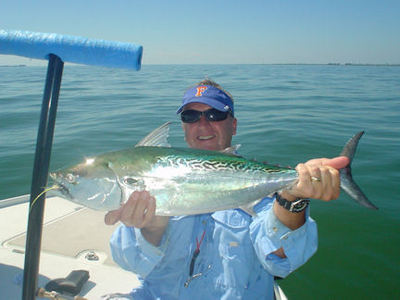This is one of my favorite months to fish. Both flats and the coastal gulf will be alive with action. Trout, reds, pompano, bluefish, Spanish mackerel and more in Sarasota Bay and snook around docks and bridges in the ICW and close to passes should be plentiful in October. In the coastal gulf, little tunny, Spanish mackerel, tripletail and tarpon should also be good options. The action really heats up towards the end of the month as the first fronts of the season push through.
Due to recent action taken by the Florida FWC, snook season will remain closed on the west coast of Florida until September 2011. We are fortunate to have an agency that is willing to take a proactive approach to managing our fisheries. This action will help restore snook stocks that were impacted by the freeze that we had in January 2010. Catch and release fishing is still allowed for snook, although anglers should use tackle heavy enough to catch and release them quickly and handle them as gently as possible.
Snook will begin moving from the surf and passes towards shallow flats of bays and backcountry areas. They usually stage around docks and bridges in the ICW as they make the transition. Small white flies, CAL jigs and DOA shrimp, as well as live shrimp and baitfish, are all good baits for snook around docks and bridges. Drifting bridge channels and vertical jigging DOA TerrorEyz along the bottom as you drift with the tide is another effective technique for snook fishing around bridges. You should also still find a few snook in the surf, particularly early in the month. Many of the same lures and flies used around docks and bridges also work well in the surf. Fish the surf when visibility is good for the best action.
You might also find snook staging along sand bars or in potholes on shallow flats. Top water plugs, fly poppers, CAL jigs with a variety of plastic tails and large profile baitfish fly patterns such as Deceivers or Enrico Puglisi flies should work well for snook on shallow flats. Fish peak tidal flows in the ICW or shallow flats for the best action.
Reds may still be in large schools early in the month, but should start to break down into smaller schools by later in the month. Look for large wakes or patches of nervous or slick water to find schools. Once you've located a school of reds, try to get ahead of them as quietly as possible and work around the edges of the schools. Casting top water plugs or fly poppers is a good way to make fish show themselves. I also like to cast large profile plastic baits, such as CAL jigs with jerk worms, to schooling redfish. Once schools of reds start to thin out, look for singles, doubles and smaller schools along mangrove shorelines, in potholes and along sandbars.
You might also find large trout in shallow water in many of the same places that you'll find snook and reds. Casting top water plugs, CAL jigs with plastic tails, DOA Deadly Combos or fly poppers and large profile baitfish patterns are good ways to find big trout in shallow water. Adding sound to the equation, such as fly poppers, Gurglers, DOA Deadly Combos or top water plugs, is often very productive. Work the edges of potholes or seams where grass and sand meet along the edge of sandbars to find them. Your best chances at a "gator" trout will be when the light is low. Shallow flats and sand bars of north Sarasota Bay are some of my favorite areas for snook, reds and big trout.
You'll also find trout on deep grass flats along with pompano, Spanish mackerel and bluefish. I like to drift and cast ahead of my drift with CAL jigs and plastic tails, DOA Deadly Combos or weighted flies, such as my Grassett Deep Flats Bunny, to find fish. You can also look for diving terns or bait being forced out of the water to locate fish. I like to make a series of drifts to locate fish and then shorten my drift to zero in on them. You may also find pompano, Spanish mackerel and bluefish in passes where you'll need to use heavier jigs and flies along with sinking fly lines. When Spanish mackerel and blues are around, you'll need to use wire or heavy fluorocarbon leader to prevent them from biting through your leader. I prefer heavy fluorocarbon, since it is less visible than wire, and should result in more hook ups.
The coastal gulf should be a smorgasbord this month as southbound baitfish pods are attacked by king and Spanish mackerel, blues and little tunny. Tarpon may rally and feed heavily on baitfish schools as they prepare for their fall migration away from our area. Look for diving terns, baitfish being forced out of the water or fish feeding on the surface to locate them. If you don't find them on the surface, one of the many artificial reefs may hold them. I like to drift over structure with CAL jigs or weighted flies on fast sinking fly lines to find fish in these areas. In addition to structure, you should also be able to find baitfish schools or schools of larger predators with your bottom machine.
You might find cobia and tripletail around crab trap floats, buoys and channel markers in bays or the coastal gulf. Cobia might also be free swimming on the surface or over structure at one of the many artificial reefs off Sarasota. Cobia will require heavy tackle since you could easily run into a large cobia that is 20 to 30-pounds or larger. I like to use a DOA shrimp or a slow sinking shrimp or baitfish fly pattern on a floating or intermediate sink tip fly line for tripletail.
October is a great month to fish the flats and coastal gulf waters, particularly towards the end of the month after the first fronts of the season push through our area. I like to fish the coastal gulf when conditions are good, but Sarasota Bay will offer good protection and plenty of action when the wind blows from the west. Whatever you choose to do, remember to limit your kill, don't kill your limit!
Tight Lines,
Capt. Rick Grassett
Snook Fin-Addict Guide Service, Inc.
FFF Certified Fly Casting Instructor
(941) 923-7799
E-mail snookfin@aol.com
www.flyfishingflorida.net and www.snookfin-addict.com




